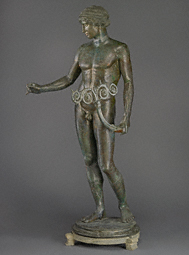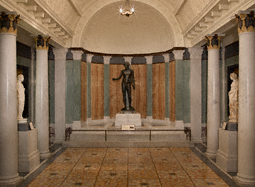 |

 |
 |
Youth as a Lamp Bearer, Roman, from Pompeii, 20–10 B.C. Soprintendenza Speciale per i Beni Archeologici di Napoli e Pompei
|
 |
Youth as a Lamp Bearer, a long-term loan from the Museo Archeologico Nazionale in Naples, is on view at the J. Paul Getty Museum at the Getty Villa.
Created about 20-10 B.C., the Roman bronze figure of a ephebe, or youth, was excavated in 1925 in a well-appointed residence, now called the House of the Ephebe—named for this statue—off Pompeii's Via dell'Abbondanza. Referred to as the Efebo Lampadoforo (Youth as a Lamp Bearer), the figure holds ornate tendrils that served as candelabrum branches.
Like many other pieces found in Pompeii, it is a Roman work in Greek style; the youth is modeled after earlier, Greek sculptures of athletes. Created as an ancient lamp stand, the ephebe still stands on his original base, consisting of a bronze disk and stone tripod.
|

 |
 |
Youth as a Lampbearer
on view in the Basilica Gallery at the Getty Villa
|
 |
 |
At the time of the eruption of Vesuvius, the Youth was being stored together with other bronze furnishings in a central room off the atrium. The house was in the process of being refurbished, and the sculpture had been covered with a protective cloth, traces of which are still visible on the figure's shoulder and thigh. The ephebe survived the volcanic cataclysm in an excellent state of preservation. Found with its right arm broken off and the candelabra detached, the Youth was restored in the mid-1990s at the Centro di Restauro in Florence—a treatment that revealed that the youth's lips and nipples were crafted in copper.
|